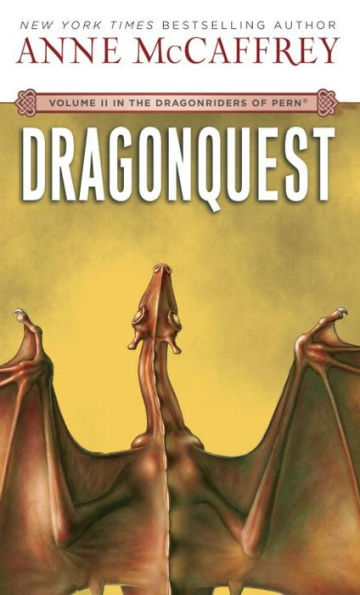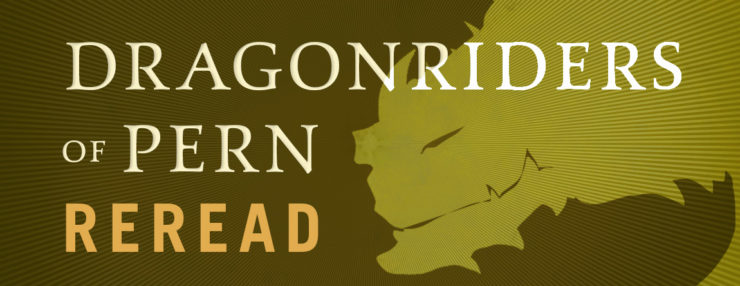Anne McCaffrey later admitted that she found writing Dragonquest (1971) very difficult. Vestiges of these difficulties can be found in the middle sections of the novel, which contain several minor inconsistencies, repetitions, and viewpoints—signs of hasty rewriting, perhaps, or possibly McCaffrey both trying to work out what this novel would be about, while also questioning aspects of the world she had created.
But if she couldn’t reduce the size of her problems, she could reduce the size of something else—her dragons, those huge creatures large enough to carry four or five human riders at a time, and powerful enough to strike down alien life forms from the air. Those she could miniaturize into tiny, adorable fire-lizards.
It worked so well that most of her later Pern books would sparkle with their antics.
Part two of Dragonquest doesn’t just introduce fire-lizards, but continues to explore the rather fraught situation at Southern Weyr. The somewhat isolated Weyr, founded only eight Turns ago, has certain advantages—great weather, plenty of food, not too many Threadfalls—and two major issues. First, the Southern Weyr has been transformed into a hospital for injured dragonriders, straining Varena and Brekke, the two queen riders tasked with handling their care. Second, their Weyrleaders, Kylara and T’bor, are at odds, to put it mildly.
F’nor, still healing from his wound, is ordered to ignore all of this and just go and rest, so he climbs aboard Canth, his dragon, and goes flying off to a beach, something that doesn’t sound all that entirely safe for someone recovering from a major wound, and also something that makes me wonder why, exactly, F’nor can’t return to Benden if he’s able to fly on top of a dragon, even if he can’t fly between yet. Moving on. At the beach, he takes a nap, and wakes up to find a little golden fire-lizard on his arm—a creature straight out of legend, that apparently no one on Pern has seen for centuries, if not longer.
Buy the Book


Dragonquest
After Canth somewhat belatedly tells F’nor that more fire-lizards have just hatched nearby, F’nor frantically summons other dragonriders, who manage to Impress a few more of the tiny creatures, though most of that clutch die, killed off by local wildlife—rather neatly explaining just why no one on Pern has seen fire-lizards for centuries. They return to the Weyr clutching the small survivors. Kylara shows up, and tries to take one. In an unpleasant moment, F’nor considers beating her, saying that a sound thrashing is what she needs —this, despite seeing bruises on her arm. More about this in the next post.
It’s not all fire-lizards, though. Up north, the young and frequently bullied Lord Jaxom of Ruatha and his guardian, Lytol, head out to Benden Weyr. Felessan, the young son of Lessa and F’lar, promptly drags Jaxom off to sneak a look at Ramoth’s eggs. While there, Jaxom notices a small egg, far apart from the others, and touches it, despite the protests from Felessan, who notes that no one touches eggs, ever, until they are candidates. They leave the Hatching Grounds in a panicked rush—and soon find themselves lost in one of the oldest parts of Benden, where they accidentally open a long-forgotten door.
During all of this, Lessa, F’lar, Lytol, Robinton and Fandarel have a troubled discussion about the problems with the Oldtimers, who, apart from starting duels over belt knives, have apparently been failing to clear Thread from all locations—causing the loss of valuable farmland and forests—as well as taking excessive products and kidnapping women. (It will perhaps not surprise anyone that the kidnapped women barely get mentioned again.) Fandarel’s solution: Create distance writing machines to improve communications, which certainly seems like an improvement over the drumming. They all urge F’lar to step forward and take leadership in this crisis.
That settled, they set out in search of the missing Jaxom and Felessan. The boys have collapsed right in front of a forgotten room, which has apparently not been entered since ancient days (a story told years later by Todd McCaffrey)—and which contains a microscope. It takes F’lar approximately one minute to realize that if an instrument can make small things look bigger, surely something can be designed to let him look at the Red Star—and possibly travel there by dragon. DUN DUN DUN!
Plus, as Fandarel points out, this room is probably only the first of several.
Down in the Southern Weyr, Kylara finds a clutch of fire-lizard eggs, and harvests them in order to improve her sex life. No, seriously, her response to finding fire-lizard eggs is to harvest them and bring them to Lord Meron of Nabol, the man who has been leaving bruises on her skin (which she enjoys). He is annoyed, partly because, as Kylara realizes, he’s found someone else to sleep with, partly because she woke him and everyone else up, and mostly because he is initially unsure of how fire-lizards will benefit anyone. That is, until Kylara points out that the fire-lizards have all of the abilities that dragons do.
The hatching goes terribly, killing most of the little fire-lizards.
Elsewhere, F’lar and Lessa fly off to the Smithcrafthall, on individual dragons, even though Mnementh is certainly capable of carrying more than one rider and the text regularly tells us that Ramoth is very protective of her eggs. (In later books, a queen dragon flat out refuses to leave her eggs, with dire consequences; this book feels more tentative on this question. Certainly the fire-lizard queens don’t seem to stick around.) Here, they get to see the new distance viewer in action, and also find out that most of the Smithcrafthall’s domestic staff has decided to give up cooking and cleaning in favor of helping to build new machines—a revelation that horrifies Lessa, who says she will send over three women who have been doing nothing but “make-work” to handle the cooking and cleaning. F’lar notes that the crafts need to reach out to each other and communicate more, since many of the skills the Smiths need just happen to be ones that the Harpers have.
F’lar flies back down to the Southern Weyr, annoyed to find nearly everyone headed out to the beaches to hunt for fire lizards. He has to admit, however, that Southern Weyr responds swiftly to Threadfalls—even unexpected out of schedule Threadfalls—a fight he joins in, since F’nor is still recovering from his wound. As he and Mnementh fight Thread, Mnementh notices something bright in the leaves, and F’lar realizes that Thread has slipped past the dragons—but not burrowed into the ground, the way it usually does.
This should be good news, but F’lar is disturbed.
This is a depressing note to end on, so let’s move on to this section’s definitions:
Fire-lizard: A tiny little dragon, small enough to be held in one hand at birth, in the arms or on a shoulder as an adult, with some basic telepathic abilities—that is, they can project and receive emotions and images, but not words. I want one.
Candidates: Young men—and the occasional woman—allowed to touch eggs. Ordinary eggs and dragon eggs.
Distance writers: The name given by Mastersmith Fandarel to his latest invention, a telegraph machine.
Make-work: What at least some of the women in Benden Weyr appear to be doing instead of the exciting stuff of exploring the lost, forgotten chambers and getting knocked out by the gases still inside those chambers. Or nursing injured riders and dragons.
Or constantly repeating material to fill up your contracted word count.
Which, ordinarily I would be complaining about—just how many times do we need to be told that the Oldtimers have different attitudes and that this is causing problems (I get it, ok? The Oldtimers are old)—but, well. I’m distracted. Because fire-lizards. Adorable, charming, fire-lizards. We know they’re adorable and charming because every single character, right down to the angry, miserable Kylara and the angry, miserable unnamed servants of Lord Meron, is immediately charmed by them. And why not? They are tiny dragons. Tiny dragons capable of projecting emotions—including love and adoration of their owners. What’s not to be charmed by?
But also, they are charming because anyone—anyone—can have one, dragonrider and non-dragonrider alike. Deserving and undeserving alike. Able to talk to dragons or not. (Though I have to assume that, by this point in Pern’s history, nearly everyone has inherited at least a touch of the telepathic abilities that allowed humans to bond with dragons in the first place, so that may not mean all that much.) Even the deeply unsympathetic Meron, disliked by dragons, manages to entice a little fire-lizard to stay with him.
Not to mention that fire-lizards seem happy to ignore the other “rules” of rider-dragon pairings: Men can Impress the golden queen fire-lizards, reserved for women in the Weyrs; women can Impress bronze, brown, blue and green fire-lizards, a privilege reserved for men in the Weyrs (which, since most of the dragons are bronze, brown, blue and green, ensures that most dragonriders are men); and perhaps most impressively, people of all genders can impress multiple fire-lizards.
It sounds ideal. But interestingly enough, this introduction is paired up with multiple examples of the negative effects that Impression and bonding with dragons can have on dragonriders and even an entire Weyr. Earlier, incipient dragon sex had caused one dragonrider to attack another one. In this second, dragon mating flights have paired up Kylara and T’bor—two people entirely unsuited for each other, to the point where Kylara isn’t just sleeping with someone else (or multiple someone elses), she is handing off fire-lizard eggs to non-dragonriders in the hopes of weakening the Weyrs who put her into this situation in the first place. Combined with the dire hints from T’ron, it all suggests that at least some of the negatives of the dragon bonds may outweigh the positives.
And yet none of this seems to bother any of the people eagerly hunting for fire-lizard eggs. Indeed, for all of the clear issues that dragon sex has brought her, Kylara even seems to assume that fire-lizards will enhance her sex life with Meron—a pleasure great enough to be worth the tedious hours hunting for fire-lizard eggs on beaches.
Hmm.
Though I’m still left with one major, nagging question: How, after seven years of living there, has no one in Southern Weyr noticed that Thread just… disappears shortly after landing on the southern continent, in stark contrast to what it’s doing up in the North of Pern?
Mari Ness currently lives rather close to a certain large replica of Hogwarts, which allows her to sample butterbeer on occasion. Her short fiction has appeared in Clarkesworld, Lightspeed, Fireside, Apex, Daily Science Fiction, Nightmare, Shimmer and assorted other publications—including Tor.com. Her poetry novella, Through Immortal Shadows Singing, was released in 2017 by Papaveria Press. You can follow her on Twitter @mari_ness.










